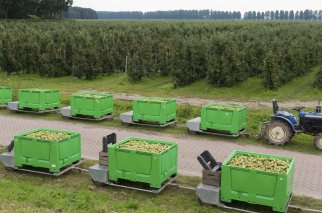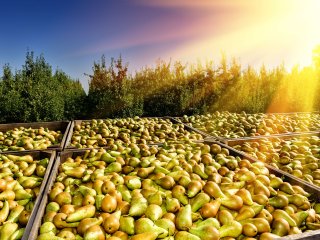
Temperature management pears
An optimal temperature is mostly the first requirement to maintain a good quality of horticultural produce after harvest. Refrigeration is an effective method of preserving the quality of pears. Cooler temperatures extend the storage life by, among other things, reducing respiration, water loss, colour change, and decay. The produce should however not be stored below their critical temperature, as chilling injury may then occur. This would result in risks on various quality problems such as weakened tissue leading to discoloration and increased risk of decay. The optimum temperature varies per commodity and should be controlled throughout the whole fresh supply chain.

Optimal storage temperature
Attention points before the pears enter the storage room

Pears should be cooled rapidly after harvest. Ensure that the product ends up as soon as possible in a refrigerated area after harvest. Optimally within a few hours after harvest. Never leave the product outside with thinking the heat will pull out during the colder night. The temperature difference between fruit and outside temperature is mostly not big enough. Moreover, there is outside often not enough air circulation for an effective cooling of the pears in the middle of the stack.
The storage room should be at the optimal temperature during a number of days before the first pears enter. In this way, more refrigeration capacity is available to cool down the pears when room loading begins. The setpoint for the air temperature during room loading varies per pear variety and harvest maturity. A maturity and quality check of the pears is highly recommended to refine decisions about temperature management.
Factors determining optimal storage temperature
Heat sources in a storage room
Temperature sensors in a storage room
-

Control sensor. Photo by WFBR Control sensor
The storage room contains a number of temperature sensors. For the cooling operation, the control sensor that measures the air temperature at a fixed position is important. This sensor is commonly placed in the air flow on the suction side of the evaporator. It is used to regulate the on/off cycling of the cooling. -

Product sensor. Photo by WFBR Product sensors
The use of product sensors (with probe inside the product) are strongly advised at least at the coldest position and at the warmest position in the room. There are always some differences in product temperatures in the cold store (preferrably < 0.5 °C). The warmest place of the storage room is mostly underneath the evaporator of the cooler. While the coolest place is along the air flow towards the opposite side of the room. -

Handheld sensor. Photo by WFBR Hand held sensor
A handheld thermometer must be available. This should be used for routine product temperature control. In rooms under Controlled Atmosphere (CA) conditions this can be done via the control window. In this case, the safety instructions must be known and followed.









